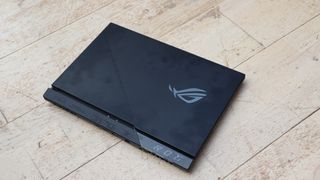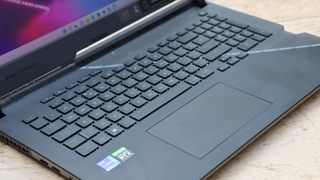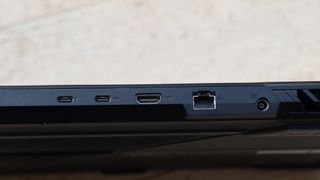IT Pro Verdict
Pros
- +
Phenomenal CPU performance
- +
Potent graphics acceleration
- +
Super-fast 2TB main storage
- +
Excellent high-refresh screen
- +
Thunderbolt 4 connectivity
- +
USB Type A also available
Cons
- -
No professional-grade graphics option
- -
Limited battery life
- -
Large and heavy
- -
No integrated memory car reader










In computing, portability used to mean significant limitations, but every year the abilities of laptops go a step further. ASUS’s ROG Strix Scar 17 showcases how powerful portables have become, with a 14-core processor, immensely potent graphics acceleration and monitor options up to a WQHD screen resolution with an incredible 240Hz refresh rate.
ASUS ROG Strix Scar 17 review: Design
In case it wasn’t clear from the name, the Scar 17 is a high-end gaming laptop, and its design caters for that market. For example, there’s a semi-translucent material around the keyboard that shows some of the underlying circuitry beneath. The ROG logo is quite stylish though, and ASUS has etched small versions of this in a diagonal line across the lid, which provides a subtle additional visual interest to the design. There is some writing etched on the lid too, but it’s only visible under UV lighting.
The diagonal logo motif is continued across the keyboard once you lift the lid. There’s also a mysterious recess on the right-hand side with an LED inside, although this doesn’t light up by default. This is for a special magnetic key that slots into place and enables a group of settings. The lighting on the lid and inside has various settings, such as rainbow or breathing. These are all gamer-focused features, but they aren’t trying to hide a lack of real power.

Although this is a heavy notebook – nearly 3kg – it’s worth bearing in mind that the components included are about as powerful as you can get in portable form. Desktop replacements in this class used to weigh over 5kg, so the Scar 17 is light in comparison, and portable if you have a bag big enough. The Scar 17 is also nearly 3cm thick, but again high-end notebooks used to be even thicker.
ASUS ROG Strix Scar 17 review: Display
The Scar 17 doesn’t have a 4K screen, but it does have a stunning 17in display. There is a 1,920 x 1,080 Full HD option, but our sample came with the 2,560 x 1,440 resolution alternative. The Full HD screen will go up to an incredible 360Hz refresh, and the higher-resolution screen can manage a still impressive 240Hz. All support Active-Sync so the refresh can match the framerate exactly, with a 3ms pixel response, which is good for an IPS panel.
Our sample’s screen delivered 100% of sRGB and 96% of DCI-P3 – less than the 100% rating, but still excellent. The maximum Delta-E variation in colour accuracy of 1.88 is good with an average of 1.12 – very promising, and close to the best desktop screens. However, the maximum brightness is only 282cd/m2, which is good but not as bright as some laptop screens we have tested. Although this is a gaming-oriented laptop, the colour gamut and accuracy will make it a good choice for professional work as well.
ASUS ROG Strix Scar 17 review: Keyboard and trackpad
Since this is a 17in chassis, there is plenty of space for a keyboard with full-sized keys and a numerical pad on the right. The chiclet-style keys are comfortable enough for extended touch typing - although one little niggle is that the hashtag key is one row up from the usual British placement, like some American keyboard layouts. This is a bit strange when otherwise the layout and key lettering are British. Until you get used to this, you may hit # instead of Enter a few times.

ASUS has sensibly moved the trackpad substantially to the left, so that it is placed almost directly beneath the spacebar. This may seem like a nit-picking point, but it’s very welcome if you’re a fast touch-typist because it minimises the risk of accidentally shifting the cursor as you type. On a more negative note, the trackpad is very shallowly recessed, with just a thin ridge around the edge. It’s quite easy to find you are pressing outside the pad accidentally if you don’t look, and even if you do look in a dark environment.
ASUS ROG Strix Scar 17 review: Hardware and performance
The ROG Strix Scar 17 has had quite a few hardware options in the past, including from AMD, but the 2022 model we reviewed uses the 12th Gen Intel Core i9-12900H processor across all variants. This “Alder Lake-H” CPU has a massive 14 cores, which come in two types – 6 are P (or performance) and 8 are E (for efficient) units. The P cores have a nominal 2.5GHz frequency with 5GHz turbo mode, whereas the E cores operate at 1.8GHz up to 3.8GHz. The 12900H in our sample was backed by 16GB of DDR5 memory in our sample, although you can specify the Scar 17 with 32GB, and the maximum is 64GB.
There are four graphics options, with all decidedly high-end. Our sample came with the NVIDIA GeForce RTX 3070 Ti, but 3060, 3080 and 3080 Ti graphics are also available. The 3070 Ti sports 8GB of GDDR6 memory and a whopping 5,888 CUDA cores, whereas the 3080 has 16GB and an even more phenomenal 10,240 CUDA cores. This is a gaming focused laptop, however, with no Quadro professional graphics-equipped version available.
There’s only one storage option listed for the Scar 17, too, but it’s reassuringly capable – a 2TB PCI Express 4.0 NVMe SSD. This delivered 7,046 MB/sec sustained reading and 5,241MB/sec sustained writing with CrystalDiskMark 8, which is faster than most desktop systems. There are some indications that a 4TB drive can also be specified, but 2TB will be enough for most users.
With such a high-performance hardware specification on board, we were expecting top scores from the Scar 17 in our benchmarks. We weren’t disappointed. The overall score in the IT Pro media benchmarks was an incredible 416, which is more than two-thirds what a current 16-core desktop workstation would achieve. The individual scores of 236 in image editing, 408 in video editing, and 482 in multi-tasking are all way ahead of the Dell XPS 17 or ASUS ProArt StudioBook Pro OLED, both of which are equipped with eight-core processors.

Hammering this home are the Maxon Cinebench scores, with 6,663 in R20, 16,114 in R23 multi core, and 1,938 in R23 single core. These results are on par with the original 16-core Ryzen Threadripper 1950X, and about 65% of the latest 16-core AMD CPUs. This is an amazing result for a laptop, and the Scar 17 can perform heavy multi-threaded tasks like a desktop workstation.
Although the NVIDIA GeForce RTX 3070 Ti graphics accelerator is aimed more at gaming, it’s extremely powerful and should be good for most professional 3D work as well. Running SPECviewperf 2020 v1.0, the Scar 17 achieved 102.74 in 3dsmax-07 and 385.8 in maya-06, showing this notebook will be excellent for 3D animation workloads. The scores of 68.55 in catia-06, 105.31 in creo-03 and 241.47 in solidworks-05 show some excellent abilities for CAD and engineering, too. However, the usual drawback of consumer-grade graphics is evident, with only 22.4 in snx-04. If you run Siemens NX, a notebook with Quadro graphics would make more sense.
ASUS ROG Strix Scar 17 review: Battery life
One area where desktop replacement notebooks always fall behind is in battery life. When the Microsoft Surface Laptop Studio can deliver nearly 17 hours of our video playback test, and the decidedly powerful Dell XPS 17 lasts well over 11 hours, the Scar 17’s 3hrs 36mins seems a bit paltry.
That said, desktop replacements of the past would barely last two hours. You could at least bank on being able to use this notebook for a couple of hours of intense work (or play…) away from the mains power plug. But there’s no way it will endure a lengthy international flight or working day. It’s clearly a laptop designed mostly to be used plugged in that you can operate on the move when you need to.
ASUS ROG Strix Scar 17 review: Ports and features
The 17in chassis format of the Scar 17 leaves plenty of room for connectivity, and reassuringly ASUS hasn’t taken the route of some other manufacturers and focused exclusively on USB-C or Thunderbolt, such as the Microsoft with the Surface Laptop Studio or Dell with the XPS 17.

Instead, on the left you get a couple of USB 3.2 Gen 1 Type A ports, so you can plug in a mouse or flash memory drive with ease. There’s a combo audio minijack for a headset, although there was room for one of these plus a separate headphone jack, which would have been useful.
There are no ports on the right, with the remaining connections on the rear. Alongside the power port is a 2.5Gb Ethernet LAN connection, full-sized HDMI 2.1 (with support for 4K screens up to 120Hz) and two USB C ports. One is Thunderbolt 4 with DisplayPort support while the other is just USB 3.2 Gen 2 Type C. In other words, the Thunderbolt 4 port supports 40GB/sec bandwidth whereas the USB 3.2 Gen 2 Type C tops out at 20GB/sec, meaning the former can support two 4K displays and supports PCI Express, whereas the latter can just do one 4K display without PCIe. Thunderbolt can also output more power to external devices.
Overall, it’s a decent port allocation, although we would have liked to see clearer symbols showing which of the two USB C-shaped connections was Thunderbolt 4. We also wish there was a built-in SD card reader, which perhaps wouldn’t be so important for a gamer but professional users would benefit. Wireless connectivity is rounded out with 802.11ax Wi-Fi 6 and Bluetooth 5.2.
ASUS ROG Strix Scar 17 review: Verdict
The ASUS ROG Strix Scar 17 is an immensely powerful laptop. Its CPU delivers the same kind of processing ability as a high-end workstation from just a few years ago. The graphics are also immensely capable, albeit aimed at gaming rather than professional work. There’s ample connectivity including the latest Thunderbolt 4 and 2.5Gbits/sec networking, plus some Type A USB for backwards compatibility.
The screen is excellent, with its high refresh able to take full advantage of the powerful graphics’ fast framerates, although this will be more for gamers than professionals. The battery life isn’t great, and it is quite large and heavy, but these are expected downsides from a notebook this potent. Overall, the Scar 17 showcases just how much computing ability can now be packed into a portable device.
ASUS ROG Strix Scar 17 specifications
| Processor | Intel Core i9-12900H |
| RAM | 16GB LPDDR5 |
| Graphics | Intel Iris Xe + NVIDIA GeForce RTX 3070 Ti with 8GB GDDR6 memory |
| Storage | 2TB NVMe PCI Express 4.0 SSD |
| Display | 17.3in 2,560 x 1,440 touch screen |
| Operating system | Windows 11 Pro 64-bit |
| Connectivity | 802.11ax Wi-Fi 6, Bluetooth 5.2 |
| Ports | 1 x Thunderbolt 4 / DisplayPort, 1 x 3.5mm combo audio jack, 1 x HDMI 2.1, 1 x 2.5G LAN, 1 x USB 3.2 Gen 2 Type-C and 2 x USB 3.2 Gen 1 Type A |
| Row 8 - Cell 0 | Row 8 - Cell 1 |
| Dimensions | 395 x 282 x 28.3mm (WxDxH) |
| Weight | 2.9kg |
| Warranty | 1yr limited hardware |
Dr James Morris has worked as a technology journalist for over 25 years, including spending nine years on the staff of market-leading computer magazine PC Pro, the last five of which were as the publication’s editor. He specialises in enterprise-grade software and hardware, with a particular focus on content creation. He launched a pioneering video channel for HEXUS.net in 2006 and ran the video reviews channel for TrustedReviews.com for four years. He also runs a successful online digital content and commercial video production company, t-zero communications Ltd.
Dr Morris is a prolific technology writer and contributes commercial content for major IT brands including AMD, BlackBerry, Dell, Cognizant, HP, and IBM. He published a book on artificial intelligence, Can Computers Create Art? in 2009. He is also an academic, and is currently Pathway Director of the MA, Interactive Journalism at City, University of London.
Previously, he was course leader for the BA in Web Media Production at Ravensbourne University. He has a PhD in Philosophy, Art and Social Thought from the European Graduate School in Switzerland, a Master's in Media Arts from the New School in New York, USA, and a Bachelor's in Social Anthropology from the London School of Economics.
Dr. Morris can be found on Twitter at @Cyberwest, or emailed at j@tzero.co.uk
